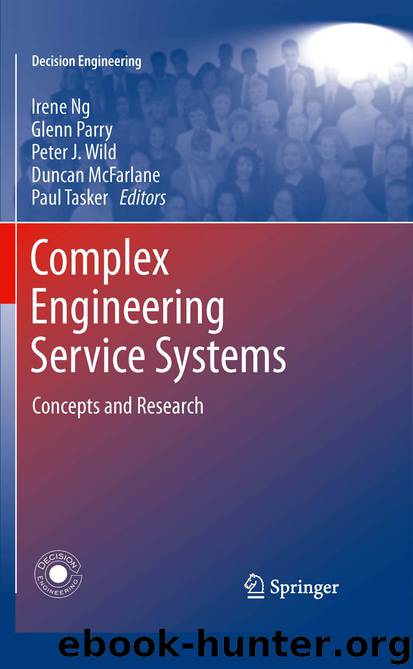Complex Engineering Service Systems by Irene Ng Glenn Parry Peter Wild Duncan McFarlane & Paul Tasker

Author:Irene Ng, Glenn Parry, Peter Wild, Duncan McFarlane & Paul Tasker
Language: eng
Format: epub
Publisher: Springer London, London
12.6 Discussion
The research that resulted in the service information blueprint concluded with a road mapping activity where future trends in service information strategies were anticipated. It was recognised that current practice in service design and development tends to focus on bespoke services created to meet the needs of individual contracts. A key area for improvement, for example in reducing costs and improving the quality and reliability of service offerings, lies in standardisation across services. A key priority in this respect lies in the use of common information system solutions which, in turn, leads to a need to use standardised service processes. In the medium term it was anticipated that service design and development activities will become more like product development activities where new offerings are built using standard parts. This would change the nature of service offering from being bespoke-to-the-customer to including standard-to-the-supplier elements and, in the longer term, variants of services that are standard to the supplier. As commonality across service elements increases opportunities for significant savings in service delivery and the use of common IT/IS services for common service functionality becomes a real possibility. Ultimately these could be used to enable service providers to manage fleets of services in a similar way to which fleets of products are managed today.
A number of drivers for product service systems development were identified and could be used to inform future generations of service information blueprint. Need for more defined/accurate information at start of process to define service
Although desirable, and what a lot of designers and stakeholders might like to have, this may not be feasible given the constantly changing landscapes for and within which services are designed and delivered. In addition, the process of designing and delivering a service might change such information. Thus, an alternative need could be to build better capability of working with processes in addition to physical products within organisations that are moving to the delivery of services. A number of discussions during the research centred on advanced business process modelling approaches and techniques such as ARIS (Scheer 2000). The service information blueprint complements these systems by enabling the association of process steps with information requirements and elements of the contract.
Download
This site does not store any files on its server. We only index and link to content provided by other sites. Please contact the content providers to delete copyright contents if any and email us, we'll remove relevant links or contents immediately.
| Automotive | Engineering |
| Transportation |
Whiskies Galore by Ian Buxton(41712)
Introduction to Aircraft Design (Cambridge Aerospace Series) by John P. Fielding(33011)
Small Unmanned Fixed-wing Aircraft Design by Andrew J. Keane Andras Sobester James P. Scanlan & András Sóbester & James P. Scanlan(32678)
Craft Beer for the Homebrewer by Michael Agnew(18076)
Turbulence by E. J. Noyes(7888)
The Complete Stick Figure Physics Tutorials by Allen Sarah(7258)
Kaplan MCAT General Chemistry Review by Kaplan(6813)
The Thirst by Nesbo Jo(6748)
Bad Blood by John Carreyrou(6468)
Modelling of Convective Heat and Mass Transfer in Rotating Flows by Igor V. Shevchuk(6349)
Learning SQL by Alan Beaulieu(6152)
Weapons of Math Destruction by Cathy O'Neil(6077)
Man-made Catastrophes and Risk Information Concealment by Dmitry Chernov & Didier Sornette(5870)
Digital Minimalism by Cal Newport;(5576)
Life 3.0: Being Human in the Age of Artificial Intelligence by Tegmark Max(5398)
iGen by Jean M. Twenge(5295)
Secrets of Antigravity Propulsion: Tesla, UFOs, and Classified Aerospace Technology by Ph.D. Paul A. Laviolette(5232)
Design of Trajectory Optimization Approach for Space Maneuver Vehicle Skip Entry Problems by Runqi Chai & Al Savvaris & Antonios Tsourdos & Senchun Chai(4949)
Electronic Devices & Circuits by Jacob Millman & Christos C. Halkias(4859)
